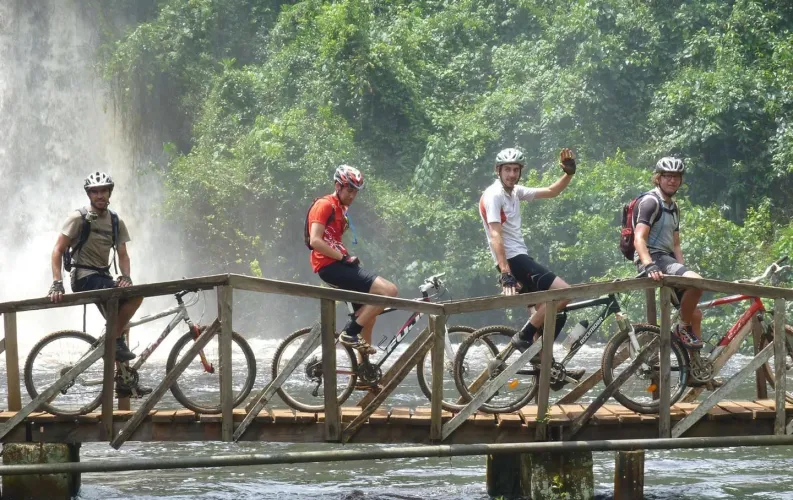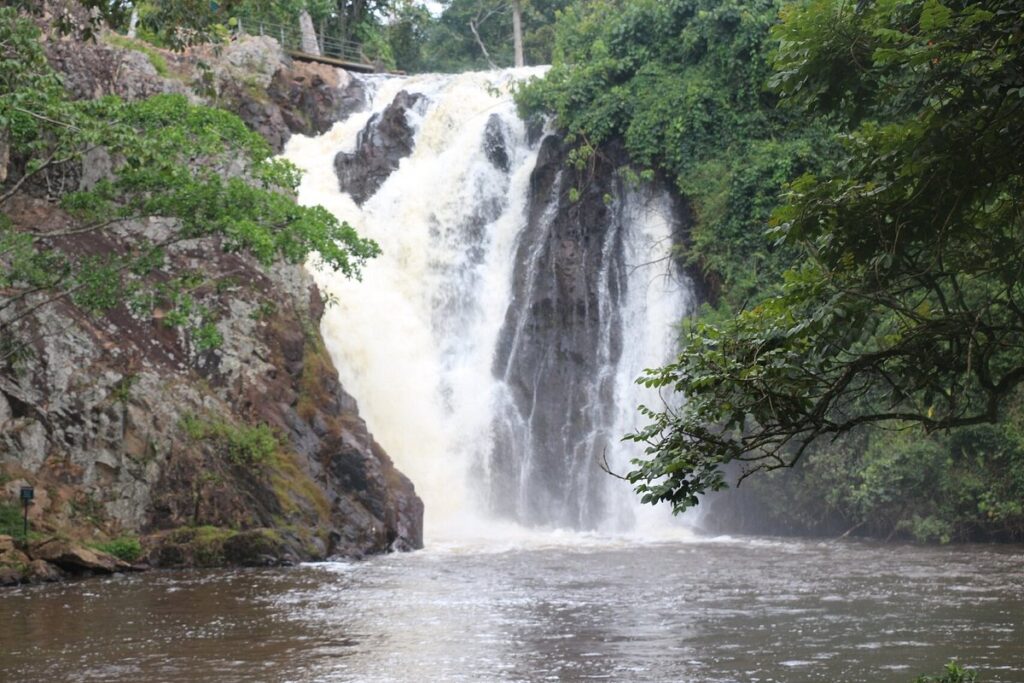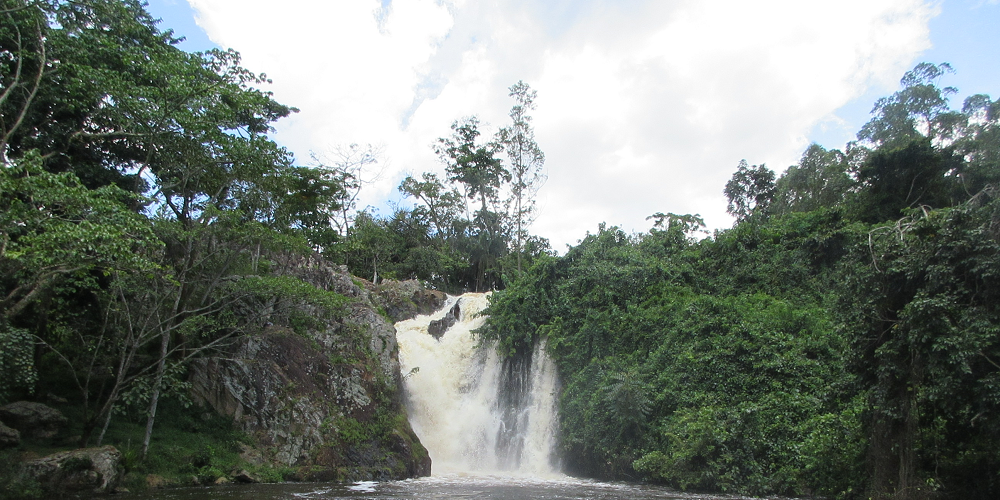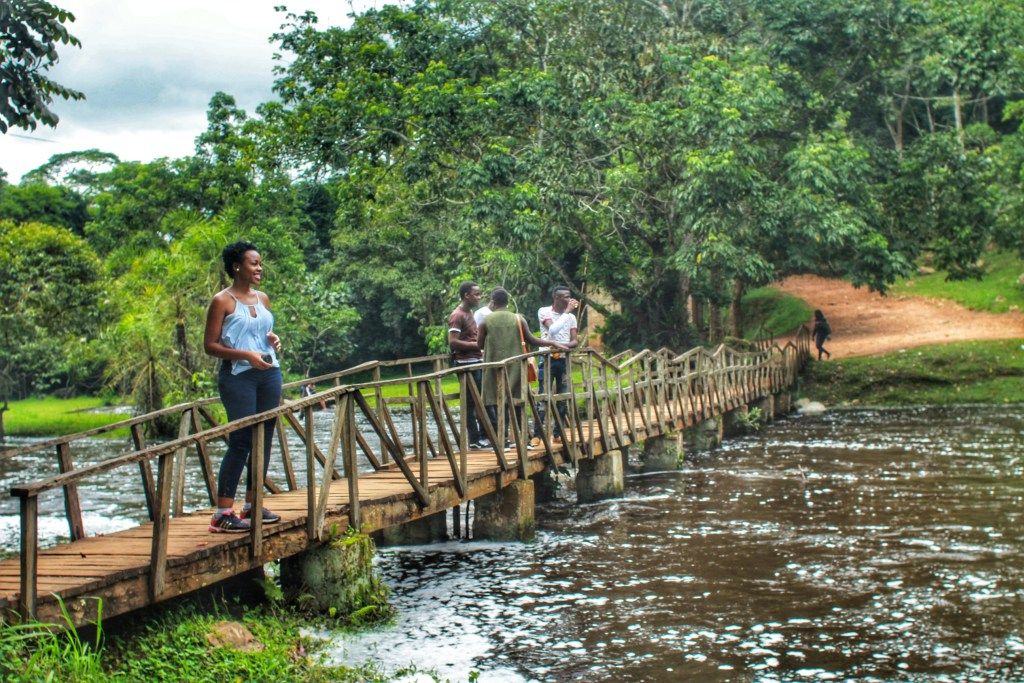Ssezibwa Falls, History, Location, Things To Do.
Ssezibwa Falls is situated 32 kilometers from Kampala city along the primary route connecting Kampala and Jinja in Mukono District. The Ssezibwa Falls are formed by water coursing through a narrow rock aperture and plummeting at a velocity of 17 meters into a substantial basin approximately 14 meters deep. The vicinity of the falls is among the premier locations for leisure following an extensive wildlife safari in Uganda or prior to reaching the source of the Nile River for activities such as whitewater rafting or bungee jumping.

The term Ssezibwa is a native expression denoting “something infinite.” The Sezibwa Falls are regarded as a significant cultural and spiritual site for the Baganda people. They are among the foremost attractions in Uganda. The facility is managed by the Buganda culture and tourist department.
The Sezibwa Falls have numerous jagged rocks and a substantial pool beneath. The Ssezibwa River flows from the falls to Lake Kyoga. The vicinity of the falls is inhabited by small primates such as Vervet and red-tailed monkeys. Species such as the African cobra, green mambas, and horned adders inhabit the area. Additional animals encompass otters, tadpoles, mongooses, and wildcats.
Sezibwa Falls located in Uganda
The Ssezibwa Falls hold significant historical, cultural, and spiritual value in Buganda. The cultural significance enhances the allure and intrigue of the falls. The Baganda hold a belief in the mystical abilities of the Ssezibwa River. A Buganda legend recounts that a woman, Nakangu Tebatuusa, experienced a conflict with her husband, Nsubuga Sebwaata, and departed from her conjugal residence to return to her parents’ home. Her father advised her to return to her spouse and resolve their conjugal difficulties. Her mother accompanied her and left her near her residence. Upon nearing her conjugal residence, she became fatigued and, while resting, delivered twins in the form of water. Her husband discovered her after being guided by a man who had observed her entering the jungle. They observed a flowing pool of water that transformed into the two rivers known as Bwanda and Sezibwa.

At its inception, Bwanda coursed eastward to Nyenga, whereas Sezibwa traversed westward, encountering numerous impediments. A spirit (Nalongo Nnkubo) assisted him in overcoming the challenges. The Spirits established themselves in the vicinity of the waterfalls, where shrines were constructed in their honor. In addition to Nnalongo Kkubo, other deities comprise Walumbe (god of death and life), Musoke (god of rain), Ddungu (god of hunting), Kibuuka (god of war), Musisi (god of earthquakes), and Mukasa (goddess of fertility, riches, and health). Due to this legend, twins are esteemed in Buganda. Their birth is regarded as a significant blessing, and rites were conducted to placate the deities. Parents are assigned specific titles such as Salongo (Father) and Nalongo (Mother). It was customary for individuals traveling near the waterfalls to cast stones into the river for blessings.
The Kings (Kabakas) of Buganda historically visited this location to obtain blessings and health. Kabaka Mwanga planted a wild olive tree, referred to as the Mwanga tree, on a journey between two of his castles in 1889. This tree exceeds 100 years in age. He was captivated by the natural beauty of the waterfalls and chose to remain in the vicinity for a period with his attendants. Upon departure, he planted a tree to venerate the deities of the falls. Cultural. Subsequently, King Muteesa II placed a tree to honor and acknowledge the spiritual significance of the Ssezibwa waterfalls and river. In 2002, King Ronald Mwenda Mutebi II visited the site to designate it as a significant tourism location in Buganda.
A tribute offered at the Sezibwa FallsAside from the kings, individuals from over Uganda continue to converge at the location to solicit blessings from the deities for their health, employment, offspring, enterprises, and families. Traditional healers invoke deities or utilize indigenous plants to treat ailments, including dental pain, gastrointestinal disturbances, and dermatological conditions. Offerings to gain the favor of the deities may consist of coffee beans, eggs, local beer, poultry, or livestock such as sheep and goats. Animals and chickens are sacrificed atop the falls and thereafter cast down to placate the gods and nourish Ssezibwa. Do not be surprised if you encounter deceased animals at the base of the waterfall.
It is noteworthy that despite the flourishing of these cultural activities, the Anglican Church possesses land adjacent to the waterfalls. Christians visit the region for retreats and contemplation. Baptismal rites are conducted in the identical waters. An essay regarding the premier heritage sites in Uganda may pique your curiosity. We offer an exceptional one-day tour package in Jinja city that includes Sezibwa Falls and various other engaging activities in Jinja.

Directions to Sezibwa Falls
What is the method to access the falls in the capital, Kampala? The distance from Kampala to the Sezibwa Waterfalls is around 30 kilometers. Upon entering the Junction leading to the falls, the roadway consists of murram. A reliable four-wheel-drive vehicle is essential for traversing this rugged terrain, particularly during the wet season. It is essential to drive cautiously and keep vigilant to avoid missing the primary intersection that leads to the falls. A signage indicates the direction to the Ssezibwa River Resort, however it is easily overlooked.
Upon entering through the reed gate, one is immediately captivated by the picturesque landscape and the soothing sounds of the waterfalls. The region is densely wooded and largely pristine. Upon advancing deeper into the facility, one observes not only the waterfalls but also a bridge beneath which the river runs downwards. The bridge provides undoubtedly the greatest vantage point for observing the falls and capturing photographs. Beyond the bridge lie rocks and other trees situated on meticulously maintained grass. All these elements converge to provide an exceptional ambiance for relaxation.
Things to do at Ssezibwa Falls
The Ssezibwa waterfalls serve as an excellent destination for leisure during weekends or holiday breaks. It is in proximity to the capital city, Kampala, and provides a tranquil and temperate atmosphere. Furthermore, it is inexpensive in comparison to other locations in Uganda. Individuals arriving from whitewater rafting in Jinja or exploring the Eastern Districts of Uganda may pause at the falls to relax and admire the pristine waters. The additional activities include:
The facility’s management advises against swimming in the picturesque pool after the waterfalls, particularly for individuals without swimming proficiency. I assume that fatalities have occurred here. If you are a proficient swimmer and like to engage with nature, no one will impede you. Who can dissuade you from immersing yourself in these waters after undertaking more challenging activities such as bungee jumping and whitewater rafting in Jinja?
Visitors to the Ssezibwa Falls in Uganda Photography:
If you seek an ideal location for exceptional photographs, Sezibwa Falls may be the destination you desire. In addition to the waterfalls, the picturesque greenery, rocks, and trees are visually appealing in photographs. You may capture photographs while engaging in sports in the gardens beyond the bridge or of the monkeys on nature hikes.
Hiking and Rock Climbing
This entails traversing the summit of the falls, where one can observe the River Sezibwa cascading vigorously down the rocks and navigating through the dense foliage. The climb may provide difficulties for the unfit, although the ultimate reward is breathtaking vistas of the waterfalls and adjacent landscapes. You might encounter lizards and various other species along route.

Birdwatching: The region encircling the Ssezibwa waterfalls is enveloped by a forest that serves as a sanctuary for more than 50 avian species. Birdwatchers will find the location exceptionally remarkable. At the base of the falls, one can observe the African Finfoot and the Long-tailed Cormorant swimming. The species inhabiting the vicinity of the falls comprise the African Finfoot, African Grey Hornbill, African Paradise Flycatcher, Ashy Flycatcher, Black-necked Weaver, Blue-spotted Wood Dove, Bronze Mannikin, Dark-capped Bulbul, Emerald Cuckoo, Fan-tailed Widowbird, Osprey, Great Blue Turaco, Green Crombec, Green Hylia, Woodland Kingfisher, Grey-backed Carmaroptera, Grey-headed Negrofinch, Grey-headed Sparrow, Hadada Ibis, Little Greenbul, Lizard Buzzard, Olive-bellied Sunbird, Red-bellied Paradise-Flycatcher, Red-chested Sunbird, Red-eyed Dove, Red-faced Crombec, Red-headed Malimbe, Ross’ Turaco, Shining Blue Kingfisher, Speckled Mousebird, Striped Kingfisher, Superb Sunbird, Tambourine Dove, Toro Olive Greenbul, Velvet Mantled Drongo, and Vieillot’s Black Weaver, along with the Western Nicator. White-headed Sawwing, White-browed Scrub Robin, White-spotted Flufftail, White-throated Bee-eater, Yellow-fronted Canary, Yellow Wagtail, Yellow-white Eye, Black and White Mannikin.
The family delights in visiting the Sezibwa Falls.Nature Walks: This is undoubtedly the most appealing activity following the observation of the exquisite falls. The adjacent woodlands are the primary destination. The primary tree species include bamboo, Muvule, Musizi, mahogany, fig, eucalyptus, and ebony. The region is replete with several bushes and shrubs. Assisted by a local guide, you will observe an increased variety of birds, butterflies, and small primates. The stroll may be extended to encompass visits to nearby farms and plantations, including those cultivating sugarcane and tea. International travelers incur a fee of approximately $4. This sum is used for compensating the Guide and for funding forest conservation initiatives.
Village Walks: Four villages are located nearby – Ngogwe, Madudu, Wamala, and Kungu. Deliberate travelers visiting the site frequently seek intimate interactions with local locals to immerse themselves in the experience of life within an African household. Students from several schools in Uganda select this location as an ideal site for fieldwork and research. The cost of this walk may be 10,000 Uganda shillings per individual.
A shrine located near the Sezibwa FallsCultural Experience:
Prior to the proliferation of Christianity and other religious practices in Uganda, the indigenous populace adhered to their traditional belief systems. Numerous shrines were constructed to facilitate connections between individuals and their deceased ancestors and deities. Jajja Ssezibwa’s Shrine continues to be a prominent attraction, situated adjacent to the picturesque waterfalls. Individuals seeking to deepen their understanding of the old cultural traditions of the Buganda people may visit the shrines to explore their historical deities and spiritual entities. The shrine is reported to include numerous spiritually significant things, including pots, bark fabric, spears, beans, calabashes, cowrie shells, and various fetishes. Smoke ascends from the base of the falls as offerings are rendered to the river and many deities. Women are prohibited from entering the shrine located within the cave. Only guys who abstained from sexual relations the preceding night are permitted. If you are a Christian, Muslim, or belong to another faith, you should reconsider whether this is the appropriate destination for you.
Recreation and enjoyment at Sezibwa FallsThe picturesque gardens surrounding the falls are ideal for picnics, intimate family gatherings, and celebrations without causing disruption to others. Establish a picnic area beneath one of the towering trees to relish the refreshing wind, observe the magnificent waterfalls, and engage in games while enjoying quality time with family or friends. Individuals interested in camping will discover the well maintained sites beyond the bridge to be ideal. Camping near the Sezibwa Falls provides a refreshing atmosphere accompanied by the melodious sounds of avian species and primates. While beverages and meals are available at the Sezibwa Falls Resort, we advise bringing your own to prevent potential dissatisfaction with the subpar services offered there. Be advised that you will be camping alongside local individuals who visit the shrines.
Details of a visit to the Ssezibwa Falls
The admission charge is approximately 10,000 Uganda shillings ($3).
The Sezibwa Falls are accessible year-round; however, to witness their full magnitude, a visit during the wet season is recommended.
Regrettably, similar to the situation at Sipi Falls in Kapchorwa, the facility is poorly administered. It is regrettable, particularly given the substantial potential of the location, should the administration become more proactive and imaginative. The location lacks a restaurant, and the sole motel available is of inferior quality. I am confident that with enhancements in some areas, the establishment will attract more guests and revenue. Visitors seeking to immerse themselves in this pristine surroundings for a day or two, while anticipating exceptional cuisine and superior services.
